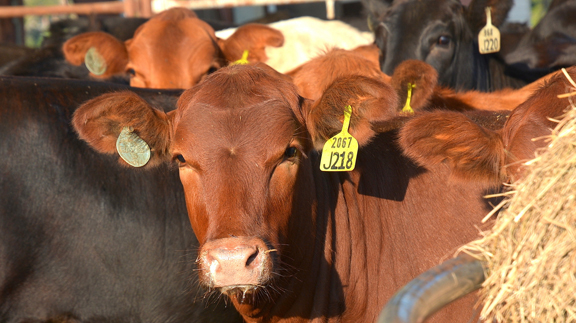Farm & Ranch
Report: U.S. beef cow inventory increased 2 percent from 2014

By: Blair Fannin
Rebuilding gaining momentum
Writer: Blair Fannin, 979-845-2259, [email protected]
Contact: Dr. David Anderson, 979-845-4351, [email protected]
COLLEGE STATION – U.S. beef cow inventory increased 2 percent from a year ago, signaling expansion among herds across the nation, according to the latest U.S. Department of Agriculture-National Agricultural Statistics Service cattle report.
“I thought the report showed more beef cows added than I expected,” said Dr. David Anderson, Texas A&M AgriLife Extension Service livestock specialist, College Station. “But record prices in the last half of 2014 will do that.”
Anderson said prior to the report, industry experts had the mindset the current rebuilding phase will be longer and slower.
“It might have to be re-thought,” he said.
Seven percent more beef cows were reported in Texas on Jan. 1 compared to the same time last year. When the final numbers come in, Anderson said it could potentially be the largest year-over-year percentage increase in Texas beef cows since 1972-1973 when the cowherd grew 14 percent.
The number of Texas beef cows remains the fewest since 1959 and 1962 for the entire U.S., not counting 2014, Anderson said.
Texas has almost 4.2 million beef cows compared to 3.91 million in 2014 and 4.2 million in January 2013. Heifers retained for breeding cows have gradually begun increasing as Texas ranchers look to restock herds following devastating drought in 2011. That year, drought caused a record $7.62 billion in agricultural drought losses, the costliest drought of all time for Texas. Livestock losses were $3.23 billion resulting from feed expense and market losses.
“In absolute numbers, the 270,000 head cowherd increase this year is the largest since 1993-1994. Heifers held for beef cow replacements were also up, nationwide, 4 percent and 7.6 percent in Texas.”
According to the report, there were 89.8 million head of cattle and calves on U.S. farms.
For stocker cattle producers, Anderson said the number of calves on small grain pastures in Texas, Oklahoma, and Kansas was reported up 300,000 head from 1.6 million in 2014 to 1.9 million in 2015. More stockers on pasture may indicate a larger number coming to market in the March-May period than last year, Anderson noted.
The 2014 U.S. calf crop was estimated at 33.9 million head, up 1 percent from 2013, according to the report. Calves born during the first half of 2014 were estimated at 24.6 million, up slightly from 2013.
Other findings from the January USDA report were:
– The number of milk cows in the U.S. increased to 9.3 million.
– U.S. calf crop was estimated at 33.9 million head, up 1 percent from 2013.
– Of the 89.8 million cattle and calves, 39 million were all cows and heifers that have calved.
– All cattle on feed increased to 13.1 million, up 1 percent from 2014.
Anderson said the cattle inventory increase is a good reminder that “record high prices and high profits are the market incentives to increase production, and that markets work.”
Anderson said market prices should remain historically high in 2015 as tight supplies of cattle continue along with good consumer demand for beef. That’s despite record retail prices for beef.
-30-
Farm & Ranch
Hazards of Backyard Poultry

By Barry Whitworth, DVM
Having backyard poultry is a popular agriculture enterprise. According to the United States Department of Agriculture, 0.8 percent of all households in the United States have chickens. People keep chickens for a variety of reasons with table eggs being one of the more common reasons.
Unfortunately, some of these poultry producers are not aware of the hazards that come with keeping poultry because many times they carry pathogens but appear healthy.
Chickens are carriers of several zoonotic diseases. These are diseases that can be passed from animals to humans. According to a recent survey in Pennsylvania, a majority of backyard poultry producers were aware of the dangers of avian influenza. However, this study also revealed that far fewer producers were aware of the risk of possible exposure to Salmonella and Campylobacter.
The lack of knowledge about the hazards of raising poultry likely contributes to the continued issues of Salmonella outbreaks associated with backyard poultry. In 2023, the Centers for Disease Control and Prevention reported 1,072 illnesses of Salmonella linked to backyard poultry, and 272 of those patients required hospitalization. Oklahoma reported 43 individuals with the disease.
To read more, pick up a copy of the April issue of NTFR magazine. To subscribe by mail, call 940-872-5922.
Farm & Ranch
Ag Elsewhere: Wyoming

By Tressa Lawrence
Babies are tucked away in every nook and cranny. Many ranchers across Wyoming have baby animals popping up all over this time of year.
Farm & Ranch
Ag Elsewhere: Montana

By Lindsey Monk
Another load of grain in to keep feeding the calves until the green grass can really start popping.
-

 Country Lifestyles1 year ago
Country Lifestyles1 year agoScott & Stacey Schumacher: A Growth Mindset
-

 Equine7 months ago
Equine7 months agoThe Will to Win
-

 Country Lifestyles7 years ago
Country Lifestyles7 years agoStyle Your Profile – What your style cowboy hat says about you and new trends in 2017
-

 Country Lifestyles4 years ago
Country Lifestyles4 years agoAmber Crawford, Breakaway Roper
-

 HOME7 years ago
HOME7 years agoGrazing North Texas – Wilman Lovegrass
-

 Country Lifestyles7 years ago
Country Lifestyles7 years agoDecember 2016 Profile, Rusty Riddle – The Riddle Way
-

 Country Lifestyles8 years ago
Country Lifestyles8 years agoJune 2016 Profile – The man behind the mic: Bob Tallman
-

 Outdoor9 years ago
Outdoor9 years agoButtercup or Primrose?






